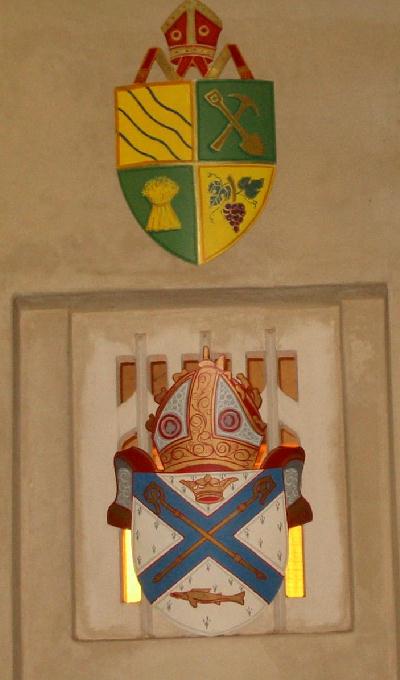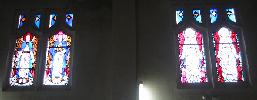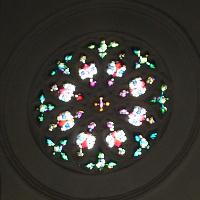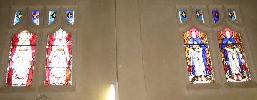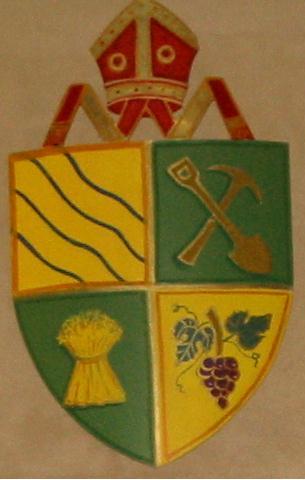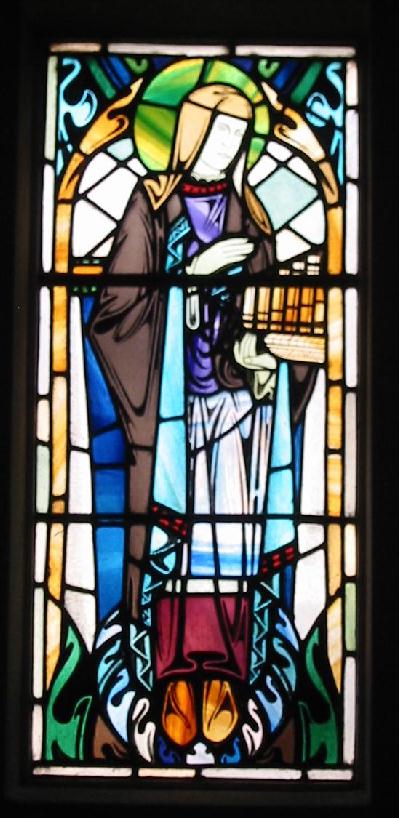 | Anglican Parish of Northern MalleePost Office Box 692, Mildura 3502, Victoria, Australia |
| Chancel | |||||||||
|---|---|---|---|---|---|---|---|---|---|
|
The chancel is the front part of the church from which the service is conducted, as distinct from the nave, where the congregation sits. It includes the Sanctuary and the Transept.
| |||||||||
| Sanctuary | |||||||||
The East End features a Round window, with Archangels depicted in the side wall.
Furnishings include the Communion Table, Bishop's Chair, and seating for people involved in the Service.
The front, or open side of the area is defined by the Communion railing, also called the chancel railing, with provisions for kneeling.
| |||||||||
| Eastern Rose Window | |||||||||
 |
The Eastern Rose Window, donated by Dr Barker, features a design symbolising the Sword and Flame of the Spirit. Also in the photo is our Perpetual Flame, remembering those killed in wars |
||||||||
| North Side | The windows of the Sanctury consist of two facing pairs | South Side | |||||||
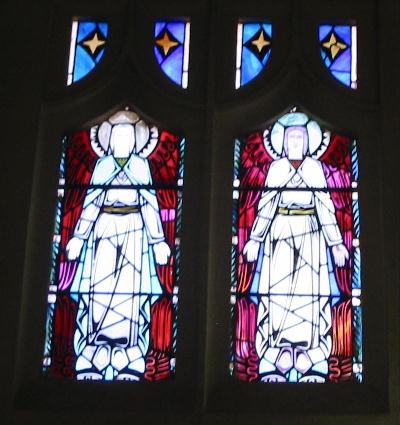 |
Closest to the East End the Archangels have white robes. The second pairs include archangels holding a golden orb and a golden crown The two shields are on the northern wall, below the Archangels. The top shield appears to represent the Red Cliffs district, and below it a Shield to St Mark. |
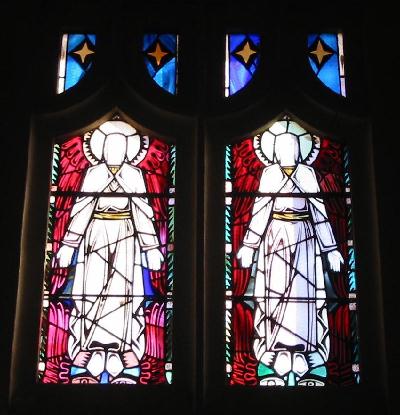 |
|||||||
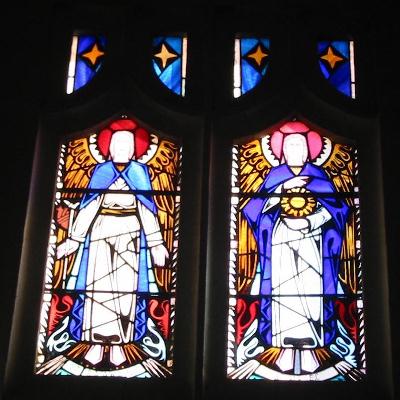 |
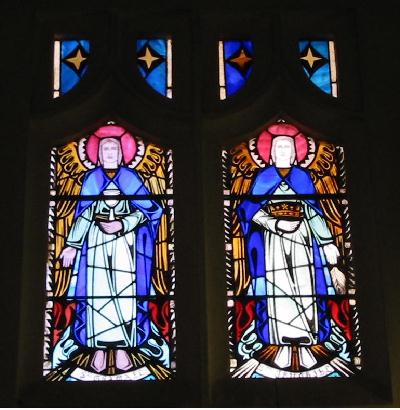 |
||||||||
| The two Shields - What is their story? | |||||||||
| The Transept | |
|---|---|
The Sanctuary or chancel is the front part of the church from which the service is conducted, as distinct from the nave, where the congregation sits. The chancel is an elevated platform, three steps up from the nave.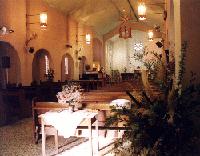 The area between the Chancel and the Nave is the Transept. This space near the chancel is to accommodate clergy, the choir, and the Organist. The space between the chancel and the nave extends beyond the side walls, giving the church a cruciform floorplan — meaning that it is cross-shaped when viewed from the air. St Marks achieves this internal plan by having three aisles, a central one plus north and south aisles divided from the Nave by a row of pillars supporting the roof, as shown in this small photo, looking towards the north wall and the Sanctuary.
The area between the Chancel and the Nave is the Transept. This space near the chancel is to accommodate clergy, the choir, and the Organist. The space between the chancel and the nave extends beyond the side walls, giving the church a cruciform floorplan — meaning that it is cross-shaped when viewed from the air. St Marks achieves this internal plan by having three aisles, a central one plus north and south aisles divided from the Nave by a row of pillars supporting the roof, as shown in this small photo, looking towards the north wall and the Sanctuary.
|
|
| The Northern Transept | |
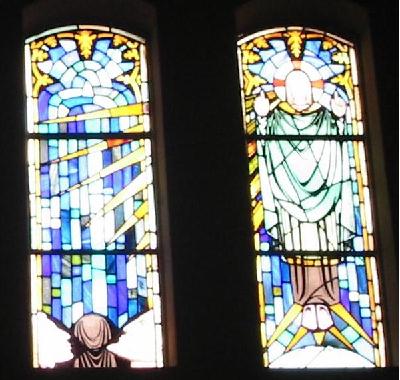 'The Ascention' - donor anonymous. | |
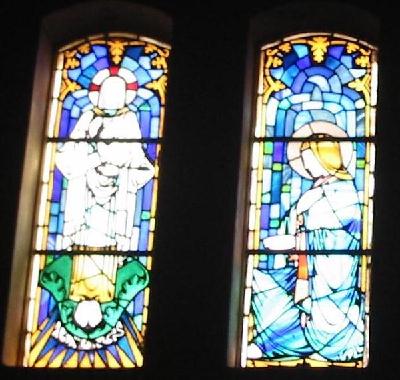 'The Resurrection' was given in memory of William (Tiny) Ditton died 18 May 1983 aged 91, and of his wife May Marea Victoria Ditton died 14 June 1990 aged 91. Tiny was 6ft 1in tall, enlisted in Sept 1914 and continued for 2015 days, including the Army of Occupation in Germany. He took up Block 396, Red Cliffs. His activities in public life include playing the saxophone for an orchestra.
'The Resurrection' was given in memory of William (Tiny) Ditton died 18 May 1983 aged 91, and of his wife May Marea Victoria Ditton died 14 June 1990 aged 91. Tiny was 6ft 1in tall, enlisted in Sept 1914 and continued for 2015 days, including the Army of Occupation in Germany. He took up Block 396, Red Cliffs. His activities in public life include playing the saxophone for an orchestra.
|
|
| The Southern Transept | |
 |
The Southern Transcept has an upper group of three, and two small windows to the left and right of the upper group recall the beginnings of church music and of English sacred poetry. St Cecilia, Virgin and martyr, patroness of church music, died at Rome, so often glorified in the fine arts and in poetry, is one of the most venerated martyrs of Christian antiquity.
|
|
The plaque on the left reads "St Cecilia - gift of Edna Frances Arnold" and on the right "St Caedmon - gift of Mrs G Holland"
|
|
| The Central Transept | |
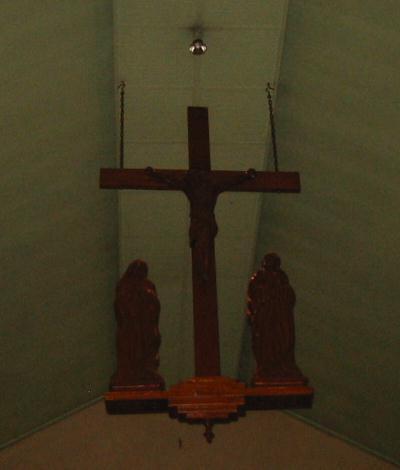
 The intersection between the Chancel and the Nave is the traditional place for a Rood Screen. In St Mark's we have a carved wooden Rood suspended from the ceiling, depicting Our Lord on the Cross, supported by his Mother, and by St John. The intersection between the Chancel and the Nave is the traditional place for a Rood Screen. In St Mark's we have a carved wooden Rood suspended from the ceiling, depicting Our Lord on the Cross, supported by his Mother, and by St John.The Lectern is a stately eagle, the gift of the Tickle family - The memorial reads "In memory of Lieut Francis Tickle, obit 17 June 1944. Presented by his wife Dora 25 Dec 1954, and also of their son Noel Francis Tickle obit 23 Sept 1931 aged 4 years 5 months." More details here | |
| North Side | Nave | South Side | |
|---|---|---|---|
'The Transfiguration' |
'The Transfiguration', in memory of Ern Powlesland, died 3 May 1980 aged 78 'Carrying the Cross', gift of Mr and Mrs EJ Dean, who had a chemist shop. |
'Carrying the Cross' |
|
'Blessing Children' |
'Blessing Children' in memory of Phillip Hauser obit 7 June 1959 and Ellen Hauser obit 21 March 1962 'Behold the Man' - anonymous |
'Behold the Man' |
|
'With the Doctors' |
'With the Doctors' in memory of Geoffrey Powlesland obit 4 Nov 1968 aged 10 years, the gift of his parents. 'Looking at Peter', gift of Mr and Mrs Ern Powlesland |
'Looking at Peter', |
|
'The Presentation' |
'The Presentation', in memory of Alma Sophy Cramp, the gift of her husband and children. 'The Agony in the Garden', gift of Miss Nancy Smith. |
'The Agony in the Garden' |
|
'The Flight into Egypt' |
'The Flight into Egypt', the gift of Mr and Mrs THW Armstrong Tommy Armstrong, born in Durham UK in 1894, served in WWI for 1535 days, and enlisted again in WWII, serving in the Middle East. He married Eva Thatcher of Kings Billabong and their daughter Margot married in 1960. Tommy worked his Block 137 till 1976, deciding to retire when aged 82! 'Institution of the Blessed Sacrament', the gift of Mr and Mrs Don Arnold. |
'Institution of the Blessed Sacrament' |
|
'The Annunciation' |
'The Annunciation', in memory of Henry (Harry) Cramp Harry Cramp, Rector's warden, died 25 June 1982 aged 81 'Palm Sunday', gift of Mrs W Langford in memory of her husband Robert |
'Palm Sunday' |
|
| The Narthex or West End | ||
|---|---|---|
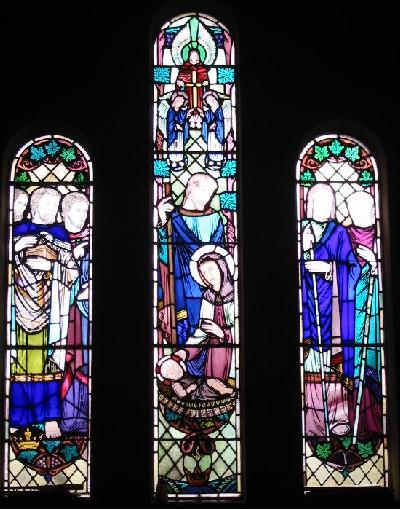 'The Nativity' |
'The Nativity' in the West end The gift of gift of Mrs Isabel Jessie Sharp in memory of her husband Frank obit 17 July 1959, aged 62. He served in WWI for 42 months, was 5 ft 5 ins tall, and enjoyed Lawn Bowling. He was granted Block 336 in 1922. | |
| The South Porch | ||
'Good Shepherd' |
'Good Shepherd', gift of Mrs Isabel Jessie Sharp in memory of her husband Frank obit 17 July 1959, aged 62. Mrs Sharp, nee Hood, was the widow of FW Hoyle. She purchased Block 342 in 1946. 'St Mark', gift of Mr and Mrs DB Stuart |
'St Mark' |
| The North Porch | ||
Revd Fettell. |
Our Builder Clergy Rev Fettell built the first timber church, now in use as the eastern half of our Meeting Rooms Canon Cracknall built the present concrete church. |
Canon Cracknall |
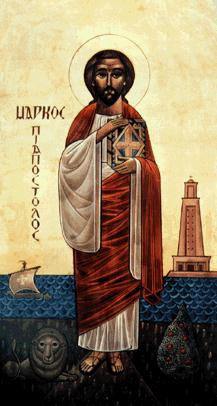


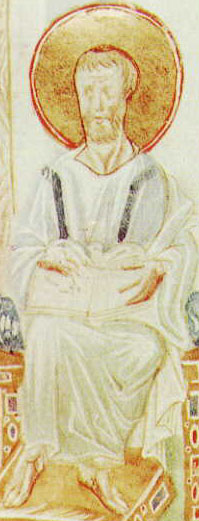
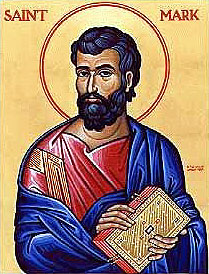
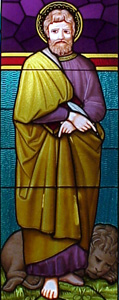
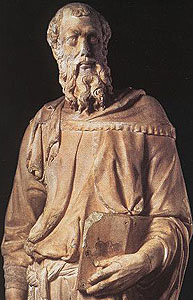 |
|
